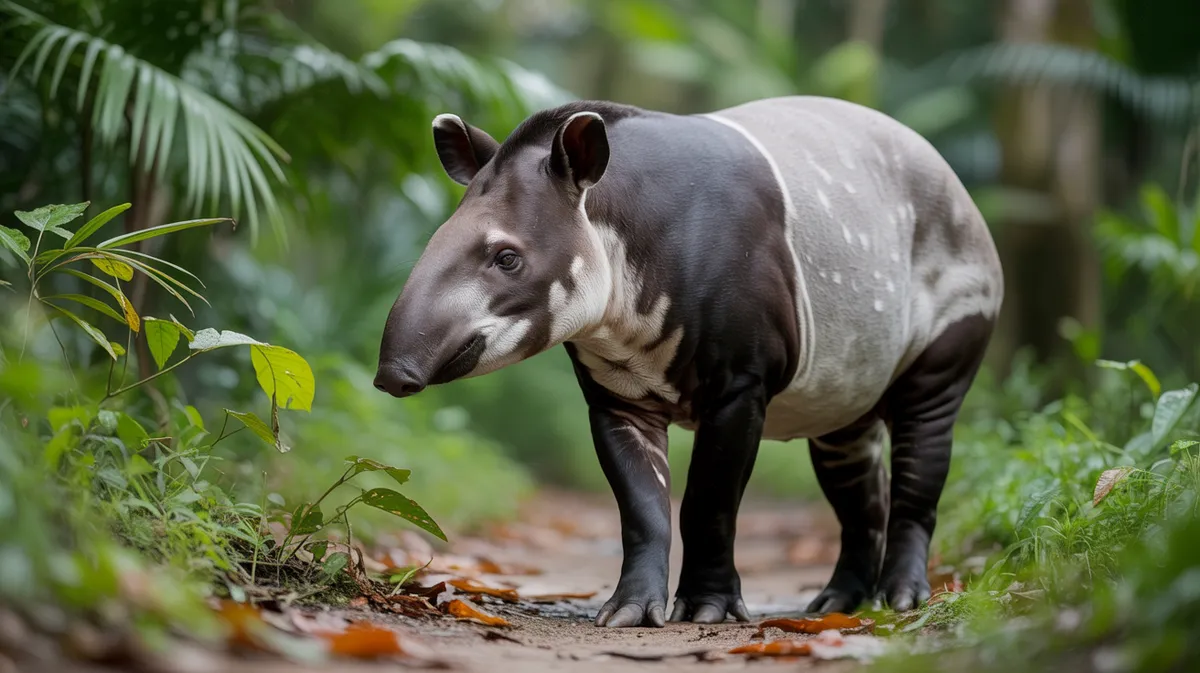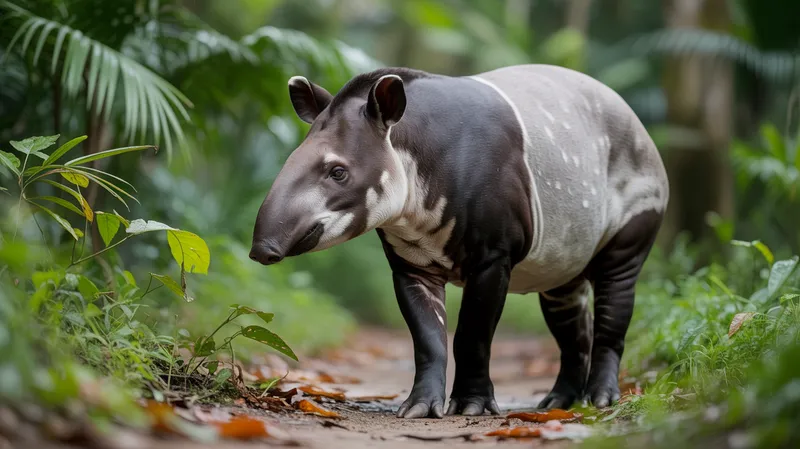
Malayan Tapir
Tapirus indicus

Meet the Malayan Tapir
The Malayan tapir is the largest of the four tapir species and is easily recognized by its distinctive black and white coloring, which helps it blend into the forest shadows and sunlight. Native to the rainforests of Southeast Asia, this shy and solitary mammal spends much of its time foraging for leaves, shoots, and fruits. Malayan tapirs are mostly nocturnal, using their excellent sense of smell to navigate dense undergrowth and avoid predators. Despite their bulk, they are agile swimmers and often seek refuge in water when threatened.
Classification
Mammal
Habitat
Tropical rainforest
Diet
Herbivore
Lifespan
25-30 years
Conservation
Endangered
Weight
250-540 kg
📖Fascinating Facts
Forest Dwellers
Malayan tapirs are primarily found in lowland forests, often near water sources such as rivers and swamps.
Flexible Snout
Their snout is highly flexible and acts like a short trunk, allowing them to grasp foliage and detect scents.
Distinctive Markings
The Malayan tapir's black-and-white coloration provides effective camouflage in the dappled light of the forest.
📋Detailed Description
The Malayan tapir (Tapirus indicus) is the largest extant tapir species, with adults typically weighing between 250 and 540 kg (550–1,190 lbs) and measuring up to 2.5 meters (8.2 ft) in length and 90–110 cm (35–43 in) at the shoulder. Its striking coloration—a black body with a contrasting white or grayish saddle extending from the shoulders to the rump—serves as disruptive camouflage in dappled forest light, breaking up its outline to confuse predators. The tapir's body is robust and barrel-shaped, supported by sturdy limbs with four toes on the front feet and three on the hind, aiding movement through soft, muddy terrain. Its prehensile snout, an extended and flexible upper lip, is highly sensitive and used to grasp foliage, fruits, and aquatic plants. Malayan tapirs are primarily nocturnal and crepuscular, spending daylight hours resting in dense vegetation or wallowing in mud to regulate body temperature and deter parasites. They are solitary animals, with individuals maintaining overlapping home ranges marked by scent. Tapirs are excellent swimmers and often enter rivers or streams to escape predators or forage for aquatic vegetation. Their vocalizations include whistles, squeaks, and clicks, used mainly for communication between mothers and young or during mating. Lifespan in the wild is estimated at 25–30 years, though they may live longer in captivity.
💡 Did you know?
Despite their pig-like appearance, tapirs are more closely related to horses and rhinoceroses than to pigs.
🔬Research & Sources
Wikipedia Summary
The Malayan tapir, also called Asian tapir, Asiatic tapir, oriental tapir, Indian tapir, piebald tapir, or black-and-white tapir, is the only living tapir species outside of the Americas. It is native to Southeast Asia from the Malay Peninsula to Sumatra. It has been listed as Endangered on the IUCN Red List since 2008, as the population is estimated to comprise fewer than 2,500 mature individuals.
Last Modified: 5/30/2025
🎭Behavior & Social Structure
Malayan tapirs are predominantly solitary, except during mating or when females are accompanied by their offspring. They are territorial, using urine spraying and scent glands on their feet to mark trails and boundaries. Their activity peaks at dusk and night, when they travel established paths to forage for leaves, twigs, fruits, and aquatic plants, often covering several kilometers in a single night. Tapirs rely heavily on their acute sense of smell and hearing, as their eyesight is relatively poor. They are known to use water as a refuge from predators such as tigers and leopards, and are capable of remaining submerged for several minutes. Social interactions are rare and usually limited to brief encounters during the breeding season or at shared feeding sites. Tapirs communicate through high-pitched whistles and squeaks, particularly between mothers and calves.
👶Reproduction & Life Cycle
Malayan tapirs are polygynous, with males seeking receptive females during the breeding season, which may occur year-round but often peaks during the rainy season (April–June). Courtship involves vocalizations, scent marking, and mutual sniffing. After successful mating, the gestation period lasts approximately 390–400 days (about 13 months), resulting in the birth of a single calf. Newborn calves weigh 6–7 kg (13–15 lbs) and are born with distinctive white-spotted and striped coats, providing camouflage in the forest understory. The mother is solely responsible for parental care, nursing the calf for up to 6–8 months, though the calf may begin to sample solid food within a few weeks. The calf's unique coloration fades after 4–6 months, replaced by the adult pattern. Sexual maturity is reached at 3–4 years of age.
🛡️Adaptations & Survival
The Malayan tapir's most notable adaptation is its prehensile snout, which functions as a short trunk, allowing it to grasp and manipulate a wide variety of vegetation. Its unique coloration provides effective camouflage in the patchy light of the rainforest, a rare example of disruptive coloration among large mammals. The tapir's thick, tough skin, especially on the neck and shoulders, offers protection against predator attacks and thorny vegetation. Its strong, splayed toes and flexible joints enable it to navigate muddy, uneven terrain and steep riverbanks. Tapirs are also exceptional swimmers and divers, using water both as a food source and as a means of escape from predators. Their digestive system is adapted to process fibrous plant material, and they play a crucial ecological role as seed dispersers, contributing to forest regeneration.
📚Research Sources
🎨Cultural Significance
The Malayan tapir holds a unique place in Southeast Asian folklore and mythology. In Malay and Thai cultures, the tapir is sometimes associated with dreams and the supernatural; in Japanese folklore, a mythical creature called the 'baku'—inspired by the tapir—is believed to devour nightmares. While not traditionally hunted for food due to its rarity and elusive nature, the tapir occasionally appears in local stories and as a symbol of forest biodiversity. In modern times, it serves as a flagship species for rainforest conservation efforts in Malaysia and Indonesia.
🔬Recent Research & Discoveries
Recent research has focused on the tapir's ecological role as a seed disperser, with studies demonstrating its importance in maintaining forest structure and diversity. Advances in camera trapping and genetic analysis have improved population estimates and clarified the extent of genetic isolation between populations. Ongoing research projects are investigating tapir movement patterns using GPS telemetry to inform corridor design and habitat connectivity. Conservation genetics studies are assessing the impact of population fragmentation on genetic diversity. There is also increasing interest in the tapir's response to habitat disturbance and its potential as an indicator species for ecosystem health.
🎥Wildlife Videos

Why Tapirs Love Spending So Much Time Underwater
Tapirs love to dive into the water, where they'll use their snout as a snorkel. There, they can evade jaguars, eat aquatic plants and ...
Smithsonian Channel

The Enigmatic Malayan Tapir: A Journey into the Wild
In this captivating video, join us as we delve deep into the enchanting world of the Malayan Tapir. Discover its unique habitat, ...
WildPaws Planet

Tapir in the forest - Animals Documentary Videos
Tapirs are big, herbivorous animals that are members of the Tapiridae family. With a short, prehensile nose trunk (proboscis), they ...
Bela

Meet the mighty malayan tapir
FactsByRishi

What in the World is a Tapir? | National Geographic
About National Geographic: National Geographic is the world's premium destination for science, exploration, and adventure.
National Geographic

Get Ready To Amaze : Journey of Malayan Tapir
Get Ready To Amaze : Journey of Malayan Tapir Join us on an incredible journey into the world of the Malayan Tapir! In this ...
World of Animals
🌍Habitat Information
The Malayan Tapir typically inhabits Tropical rainforest environments. Malayan Tapirs have adapted to their environments with specialized features and behaviors.
Primary Habitat:
Tropical rainforest
More detailed habitat information will be available soon.
🛡️Conservation Status
The Malayan Tapir is currently classified as Endangered. Conservation efforts are crucial for preserving this species for future generations.
Common Threats:
- 🏠Habitat loss and fragmentation
- 🌡️Climate change impacts
- 🎯Hunting and poaching
- 🏭Human-wildlife conflict
⚠️Threats & Conservation Challenges
The Malayan tapir faces severe threats from habitat loss and fragmentation due to deforestation for agriculture (notably oil palm and rubber plantations), logging, and infrastructure development across its range in Peninsular Malaysia, southern Thailand, and Sumatra. Road mortality is a significant cause of adult deaths, as tapirs often cross roads in fragmented habitats. Illegal hunting, though less common, occurs for meat and traditional medicine. The species is highly sensitive to habitat disturbance and requires large, contiguous tracts of forest to maintain viable populations. Current estimates suggest fewer than 2,500 mature individuals remain, with populations continuing to decline. Conservation challenges include enforcing habitat protection, mitigating human-wildlife conflict, and maintaining genetic diversity in increasingly isolated populations.
🔬Scientific Classification
Scientific Name
Tapirus indicus
Classification Hierarchy
🔍 About Taxonomic Classification
Taxonomic classification is a hierarchical system used by scientists to classify and organize living organisms based on shared characteristics and evolutionary relationships.
The system moves from broad categories (Kingdom) to increasingly specific ones, with each animal's scientific name typically consisting of its Genus and species.
📝Community Notes
Share your observations and insights about the Malayan Tapir with our community of wildlife enthusiasts.
Join Our Community
Sign in to share your observations and connect with fellow wildlife enthusiasts.
Sign In to ContributeNo community notes yet
Be the first to share your observations about the Malayan Tapir!
Explore Malayan Tapir
Select a tab above to learn more about this amazing animal.
📸Photo Gallery
No photos available for this animal yet.
🌟Discover More Wildlife
Continue your journey of discovery with more fascinating animals from our database
